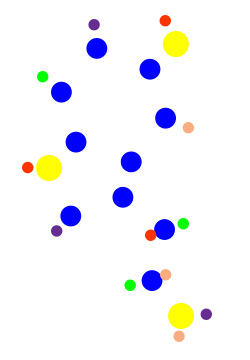Reproduction of Viruses
/The previous post explained what viruses are. This post will look at how they reproduce once they have found their host.
Bacteria, plants and animals can all be infected by viruses. Viruses, however, are only able to infect a specific host, whether it is bacteria, plant or human. For example, bacteriophages (also called phages) are viruses that only attack bacteria. Similarly, the Human Immunodeficiency Virus (HIV) can infect animal cells but cannot infect plants or bacteria. Other viruses, like the coronaviruses, mainly infect animals (their specific host range) and more rarely humans.
How do viruses replicate?
Viruses cannot replicate on their own. They are obligated to get into their specific host cell so that they can take it over to make more viruses. Because of this they are known as intracellular obligate parasites.
Basic viral replication, illustrated in Figure 1 below, requires:
1. Firstly, the virus must attach to a susceptible host cell
2. The virus then penetrates or injections its genome into the host cell
3. The virus then takes advantage of the molecules that are found in the host cell to synthesis the components for new viruses; viral nucleic acids that is its genome and proteins to make the protective capsid coat
4. Once all the components of the new virus are made, they spontaneous assembly into new viruses
5. Finally, the mature viruses are release from the host cell
In some cases, for the new viruses to be released into the environment so that they can go on to infect neighbouring cells, the host cell will have to be broken open (called lysis) resulting in its death.
Other viruses can replicate and leave without destroying the host cell, thus every time the host cell divides it passes a copy of the viral DNA onto their daughter cells, enabling the virus to spread without killing the host cell. HIV is an example of a virus that is able to incorporate its genome into that of the host cell and so survive as long as the cell does. It targets the immune cells, weakening the immune system, and it can take several years before the HIV infection advances enough for the individual to develop Acquired Immunodeficiency Syndrome (AIDS).
Recovering from a viral infection
Most viral infections will trigger the immune system to destroy the virus, for example by increasing the temperature of the body (fever). How quickly our immune system is able to fight the viral infection is determined by the amount of damage the virus will cause. Most people will usually recover quite quickly from the flu as the damaged cells in the respiratory tract can be replaced quite quickly. However, a virus such as the one which causes polio can cause permanent damage as it effects the nerve cells that are not easily replaceable.
There are no cures for most viral diseases however vaccines can help to prevent them. In cases like the flu, however, new vaccines are made every year as the influenza virus is able to mutate and evolve rapidly and therefore the viral strain will be different from year to year. For other viruses such as HIV where there are currently no vaccines available, there are numerous drugs that can keep the infection from advancing.
The next post describes how new viruses, such as the recent new coronavirus causing COVID-19, emerge and lead to diseases in humans.
If you enjoyed reading this, please like, share or leave a comment.




